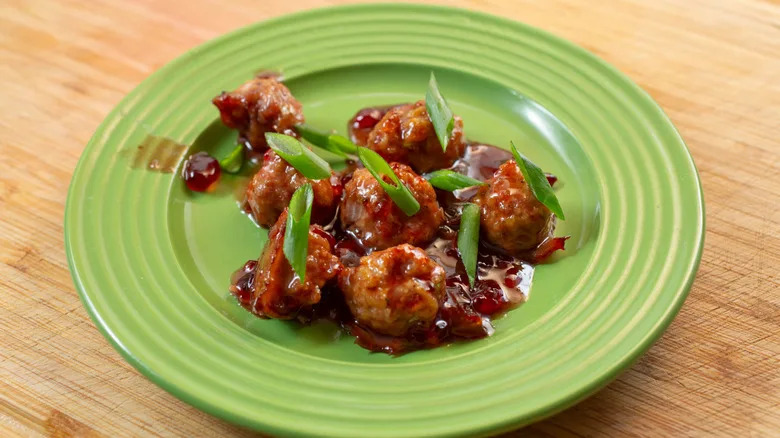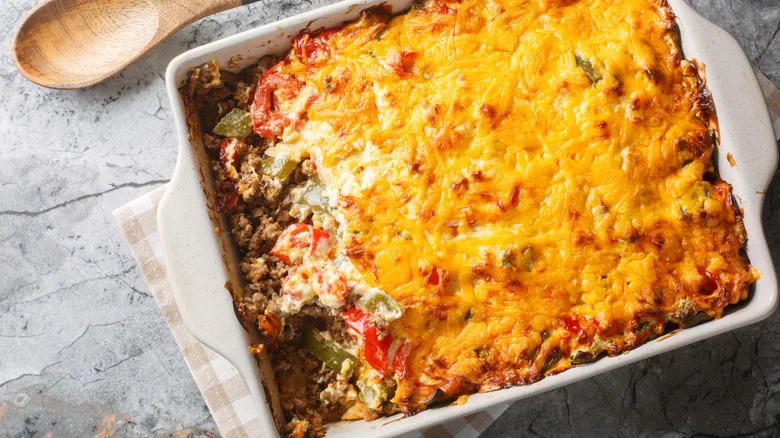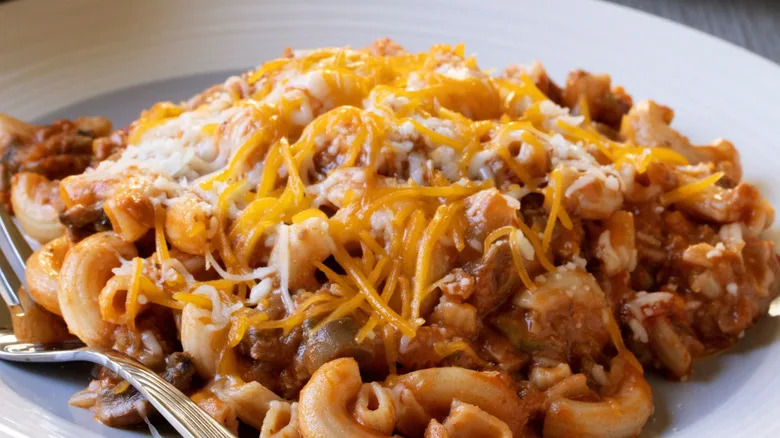Some of the most quintessential American dishes, as classic as Uncle Sam or as thrilling as NFL Sundays, are made with beef. When people think of American cuisine, some of the first dishes that come to mind are the fast-food hamburger or the family dinner meatloaf, but there are hundreds of other delicious beef recipes that have been lost to time and need a well-deserved comeback. Every year, the average American spends more on beef than on any other type of meat. The grasslands of the Great Plains proved the perfect place to raise cattle; thus, the U.S. found itself with an abundance of beef, which has since molded our cuisine and palates.
Ground beef is incredibly versatile. It can be seasoned in a myriad of ways and has found its way into thousands of different recipes over the centuries. Some of these vintage ground beef dishes, like porcupine meatballs, were created out of necessity during financial struggles. Others, like American goulash or Johnny Marzetti, tell a story of immigration and culinary fusion. Every dish has a story to tell, although some may not have a taste that can withstand the test of time. Luckily, these vintage ground beef dishes not only have fascinating histories but comforting, delicious flavors that can hold their own in 2025.
Read more: 18 Foods People Ate During The Great Depression
Porcupine meatballs
porcupine meatballs in a baking dish with tomato sauce and herb garnish – TheCooknShare / YouTube
At first glance, one might expect porcupine meatballs to be a dish using actual porcupine meat, but that is not the case. Likely named after its prickly appearance once out of the oven, porcupine meatballs are a filling, flavorful, and budget-friendly dish that deserves a resurgence. This vintage dish gained mainstream popularity during the Great Depression, but rice meatballs were spotted in cookbooks as early as 1918.
Porcupine meatballs, which are meatballs typically made with beef and seasonings, have uncooked rice mixed into the filling. As the rice cooks, bits of rice often protrude from the balls, hence the porcupine label. Typically served in a tomato-based sauce, this dish was common during the Great Depression because ingredients like ground beef were expensive and food supplies were scarce.
The foods people ate during the Great Depression were developed to maximize the ingredients on hand and bulk up recipes to make them more filling. Many creative dishes emerged, and starches like potatoes, rice, or flour were popular inclusions to bolster the meal. Although some of those Great Depression era dishes, like water pie or peanut butter-stuffed onions, might not be on your dinner table anytime soon, porcupine meatballs are flavorful, familiar, and something the entire family can enjoy.
Grape jelly meatballs
plate of grape jelly meatballs garnished with green onion – The Image Party/Shutterstock
When it comes to meatballs, dishes like classic Swedish meatballs or Italian meatballs in a rich tomato gravy are quintessential examples. Still, back in the 1960s, grape jelly meatballs were a showstopper at any cocktail party. To those not privy to the flavor bomb that is grape jelly meatballs, the dish may sound like a combination made from a game of Mad Libs or maybe a concoction featured in one of Dr. Seuss’s children’s books. However, grape jelly meatballs were once a popular appetizer, having solidified their spot in the realm of mid-century finger foods. Some of these retro dishes aren’t popular anymore, like ham and banana hollandaise or bologna cake, and are better left in the past. However, there are diamonds in the rough that deserve newfound love, and these vintage grape jelly meatballs shine through.
It’s hard to pinpoint when exactly these saucy meatballs came into the picture in U.S. cuisine, but many recipes popped up in 1960s cookbooks. One recipe, from the 1967 “Elegant But Easy Cookbook,” included raw meatballs simmered in a tomato chili sauce with grape jelly and lemon juice until cooked through. Others opted to cook the meatballs separately and pour the sauce over before serving. Although these meatballs sound like a bizarre combination, with chili sauce, grape jelly, and ground beef, the end result is actually quite delicious. The tomato chili sauce brings acidity and a hint of spice, the meat brings savory richness, and the jelly adds tangy sweetness. They’re punchy, sweet, and the perfect bite-sized appetizer that both kids and adults would enjoy.
John Wayne casserole
John Wayne casserole in dish – Sergii Koval/Shutterstock
A popular icon during Hollywood’s Golden Age, which spanned the 1920s to the 1960s, actor John Wayne was a household name. Often deemed an “everyman,” due to his work in Westerns and war films, he was one of Hollywood’s biggest stars. So how did an indulgent, meaty, cheesy casserole dish get named after him? Well, it all began with a 10-year-old girl named Cara Connery.
Connery wanted to find a creative way to fundraise for cancer research after losing relatives to the disease. She decided to reach out to thousands of celebrities in hopes of creating a cookbook that featured their favorite recipes. With the help of her mother, Connery was able to compile a book with contributions from famous people like President Jimmy Carter, Robert Redford, Captain Kangaroo, and none other than John Wayne. The original recipe contributed by Wayne was vegetarian and included eggs and cheese. Over time, new variations of the dish emerged.
If you search up John Wayne casserole, the recipes that you’ll find are mostly based on a version adapted by the University of Mississippi Medical Center cafeteria, which omitted eggs and added ground beef, jalapeño peppers, and a biscuit topping. The resulting casserole has a creamy, cheesy layer, savory seasoned beef, and a bready crust, making it the ultimate comfort food.
American goulash
Bowl of American goulash – Tatiana Volgutova/Shutterstock
American goulash is a hearty one-pot meal that has developed far beyond its Hungarian roots into a comforting dish emblematic of U.S. immigration history. Much of the foods considered American are actually dishes that came by way of immigrants and were adapted over the years to fit American palates. Hungarian goulash, the foundational dish for its American descendant, is one such recipe.
This dish had humble beginnings rooted in the Great Hungarian Plain. In the late 18th century, cowherds, groups of men, would live out on the plains to tend to the cattle. The men would eat from large cauldrons, and if they were lucky, occasionally make stews from the cattle meat itself. At some point, chili powder, specifically paprika, was added to the dish, forming some of the first instances of “gulyás hús,” or goulash, based on the Hungarian words for herdsmen’s meat.
The meat stew became internationally known, really taking off in North America. It likely arrived along with Hungarian immigrants in the mid-19th century. By the 1960s, it became one of the top five meat dishes in the U.S. Over the years, the recipe evolved, and the American goulash we know today is no longer a stew, but more of a saucy pasta dish. Like many other Americanized recipes, this one was adapted to stretch out the meal, with starch added as a filler. Classic goulash ingredients like onions, paprika, and tomatoes remain, but rather than stewed beef, the dish calls for ground beef. In another twist, macaroni pasta is added, which absorbs some of the goulash broth as it cooks, and makes it a uniquely American variation.
Johnny Marzetti
Plate of Johnny Marzetti casserole – Catherine Murray/Shutterstock
If you’ve spent any time in Ohio, you may have come across a cheesy, comforting casserole dish by the name of Johnny Marzetti. Often frequenting cafeteria menus or seen at neighborhood potlucks, Johnny Marzetti is a vintage Midwest staple. But who is Johnny Marzetti, and why is this carb-heavy dish of indulgence named after him? Well, like many U.S. vintage recipes, it is a story of immigration and new beginnings.
In 1896, Italian immigrant Teresa Marzetti arrived in the U.S. from Florence, Italy. Once here, she decided to open up an Italian restaurant in Columbus, Ohio, near the Ohio State University campus. This small Italian restaurant, called Marzetti’s Restaurant, became a community favorite. The restaurant’s creamy salad dressings developed a cult following, along with one of the most popular dishes on the menu: Johnny Marzetti casserole. Keeping the true homestyle feel of a family-run business, this casserole recipe was named after Marzetti’s brother-in-law.
A simple dish, made with heaps of cheddar cheese, ground beef, sauteed onions, mushrooms, tomato sauce, and elbow macaroni, it’s sort of a cross between mac and cheese and American goulash. The casserole gained popularity, not only in Ohio but throughout the Midwest. Its foundation is delicious on its own, but Johnny Marzetti is also incredibly customizable, making it a dish that can be adjusted to fit any family’s tastes. Adding sliced jalapeños for heat, a mirepoix for extra veggies, or a mix of cheese varieties are all great ways to elevate this versatile dish.
Read the original article on Tasting Table.


Dining and Cooking